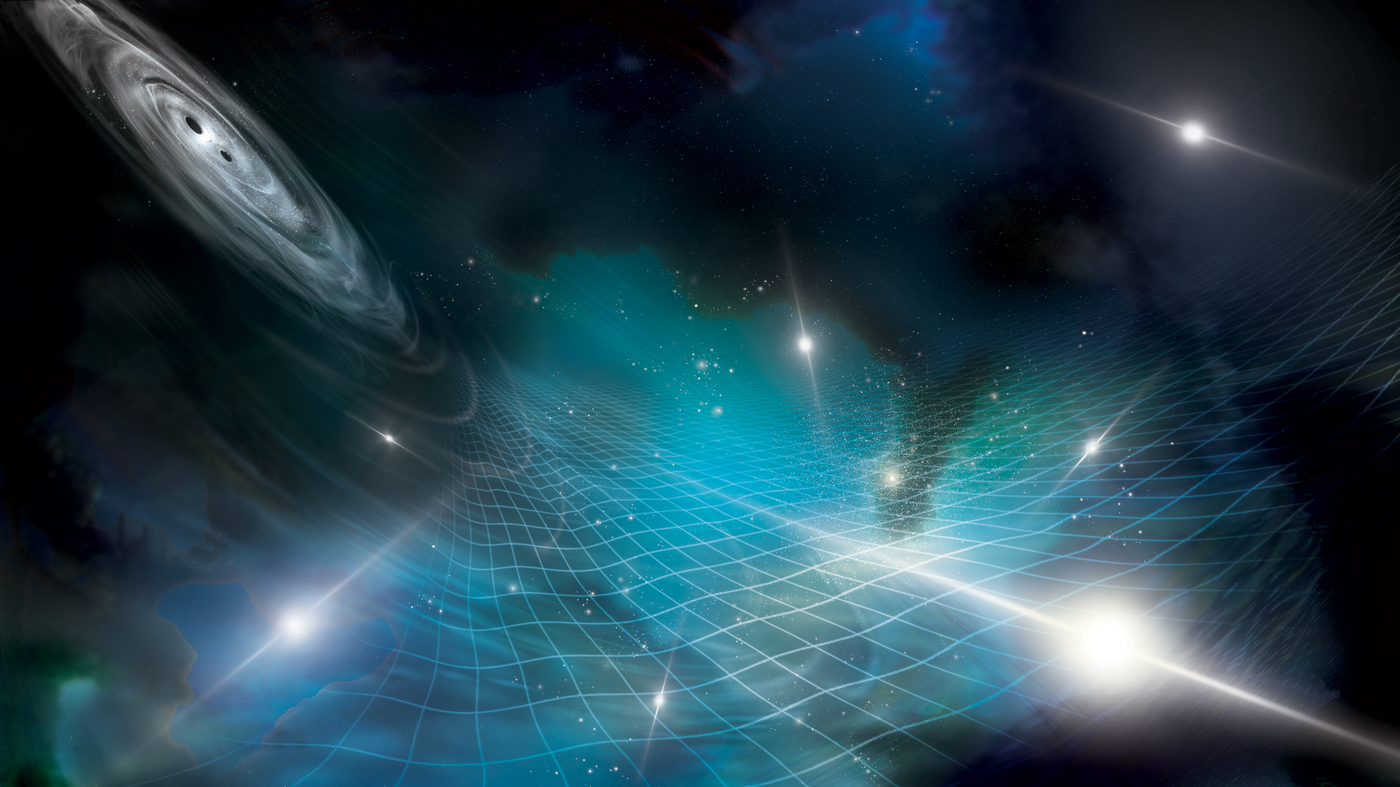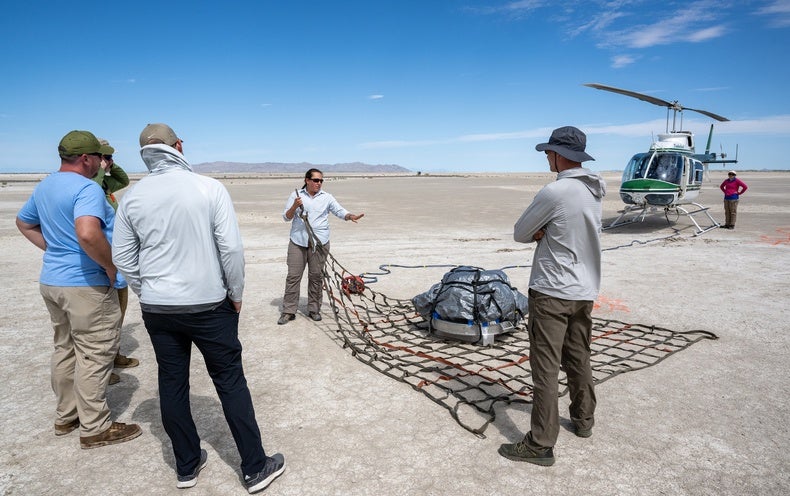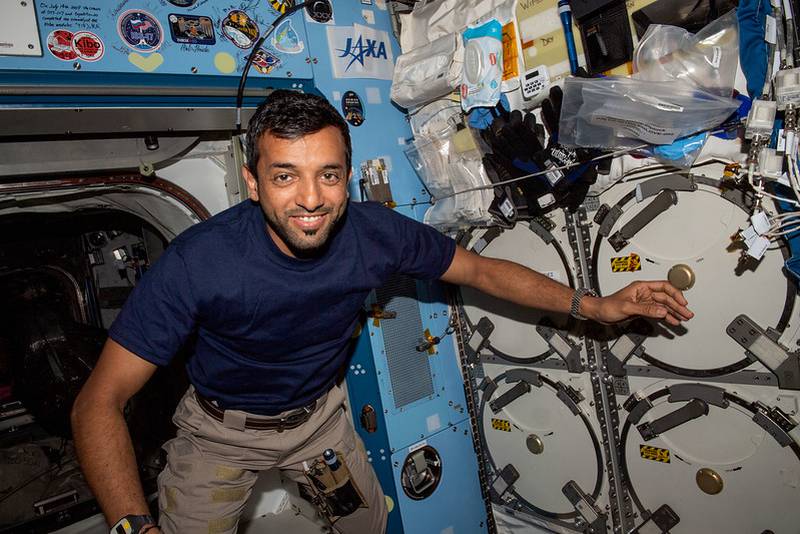Scientists have discovered indicators of a brand new sort of gravitational wave. It is actually huge
Enlarge this picture toggle caption NANOGrav/Sonoma State College/Aurore Simonnet NANOGrav/Sonoma State College/Aurore Simonnet
Scientists say they’re beginning to discover indicators of an elusive kind of rumbling by house that could possibly be created by the largest, baddest black holes within the universe.
The invention implies that astrophysicists might have opened a complete new window onto supermassive black holes. These mysterious, extraordinarily dense objects, hundreds of thousands to billions of instances extra huge than the solar, sit on the middle of galaxies like our personal.
When two galaxies merge, the large black holes at their facilities are thought to return collectively and circle one another in a spinning dance that sends large waves spiraling out.
These waves are just like the ripples that transfer by a pond when you toss in a rock — solely these waves transfer by the very cloth of the universe, and researchers have been keen to review them.
“We have been on a mission for the final fifteen years to discover a low-pitched hum of gravitational waves resounding all through the universe,” says Stephen Taylor, a Vanderbilt College astrophysicist who serves because the chair of a workforce of researchers often called the North American Nanohertz Observatory for Gravitational Waves (NANOGrav). “We’re very glad to announce that our exhausting work has paid off.”
Different analysis teams utilizing telescopes in Europe, Australia, India, and China additionally say they’re beginning to see hints of those waves.
A brand new class of house ripples
Till now, scientists have solely been capable of detect gravitational waves created by a lot smaller black holes. The primary had been seen in 2015, when a analysis consortium registered the waves created by the merger of two black holes that had been every about 30 instances as huge because the solar.
That landmark discovery confirmed that gravitational waves really existed, fulfilling a prediction made by Albert Einstein in 1916 and giving researchers a brand new solution to research unique phenomena like black holes and neutron stars.
The preliminary detection of these gravitational waves relied on a pair of specially-built gadgets, in Louisiana and Washington, that despatched lasers down two 2.5-mile “arms,” or tubes. When a gravitational wave rolled by and stretched house, these detectors might catch the extremely slight change within the distance traveled by the lasers.
That strategy labored to search out gravitational waves that stretched roughly 2,000 miles lengthy, says Jeff Hazboun, an astrophysicist at Oregon State College. However this would not work to search out the sort of long-wavelength gravitational waves created by supermassive black holes — the type whose wavelength is 4 gentle years lengthy, or “20 million million miles,” says Hazboun. To catch wavelengths that lengthy, a detector must have “arms” that stretched so long as half of the galaxy.
So researchers determined to show the galaxy itself right into a sort of detector, by benefiting from its current weirdness.
“We get to hack the galaxy,” says Hazboun, a member of the NANOGrav workforce, which has practically 100 members from the U. S, Canada, and a dozen different nations. “That is without doubt one of the most fun issues about this undertaking for me.”
NANOGrav’s approach depends on monitoring pulsars, that are the super-dense, spinning cores of useless stars. Every pulsar is small, in regards to the measurement of a metropolis, but it surely spins lots of of instances a second, sending out beams of radio emissions that recurrently sweep the sky.
“Every time their beam crosses our line of sight, we see a pulse sign,” says NANOGrav collaboration member Grateful Cromartie of Cornell College. “These pulses arrive at stunningly common intervals.”
The intervals are so common that scientists can predict precisely when a pulse ought to arrive at Earth. They’ll then search for tiny deviations from that anticipated arrival time.
“And if that pulse is somewhat bit late or somewhat bit early, then we could possibly attribute that to a gravitational wave passing by,” says Hazboun, who explains {that a} gravitational wave will stretch or compress space-time, altering the gap {that a} pulse has to journey to get to Earth.
Of their newest evaluation, which is being printed in a sequence of papers in The Astrophysical Journal Letters, the researchers checked out knowledge from about 70 pulsars.
What they discovered is a sample of deviations from the anticipated pulsar beam arrival timings that means gravitational waves are jiggling space-time as if it is a huge serving of Jell-O.
“It is actually exhausting to attribute that the waves are coming from one path or one other,” says Hazboun.
Moderately than seeing one wave come rolling in, like somebody standing on a seaside, he says, it is extra just like the expertise of swimming out in a uneven ocean.
The researchers do not but know what’s creating these waves. What they see is according to predictions about supermassive black holes, but it surely could possibly be one thing much more uncommon.
“The theorists have actually had plenty of enjoyable arising with fashions that may produce very related sorts of gravitational wave indicators,” says Luke Zoltan Kelley, a theoretical astrophysicist at Northwestern College and NANOGrav.
He says the probabilities vary from cosmic strings to darkish matter to primordial black holes that fashioned quickly after the Massive Bang.
‘Now we have been fortunate, so why not them?’
The brand new work satisfied Gabriela González of Louisiana State College, a member of the Laser Interferometer Gravitational-Wave Observatory (LIGO) scientific collaboration, which now routinely detects gravitational wave indicators from a lot much less huge black holes.
“They’ve achieved a number of very subtle analyses,” she says. “All of them verify the identical remark. There are gravitational waves right here.”
The character of this sort of proof for gravitational waves implies that certainty grows as extra knowledge from pulsars will get collected, she says, including that just a few years in the past, the information printed by this group appeared to be trending on this path.
“They’d seen very robust proof for some sort of rumbling within the galaxy. They could not verify that it was resulting from gravitational waves, however there was one thing there,” she says. “So we’ve got been anticipating this for a number of years now.”
And the NANOGrav researchers are already poring over a dataset that features a couple extra years’ value of observations.
“We count on the gravitational wave proof that we have seen on this 15-year dataset to be even stronger in that one,” says Maura McLaughlin, an NANOGrav astrophysicist at West Virginia College.
The NANOGrav collaboration, which is funded largely by the Nationwide Science Basis, additionally plans to merge their findings with related efforts by researchers abroad, as a part of a gaggle known as the Worldwide Pulsar Timing Array.
That effort ought to be full within the subsequent 12 months or two, says McLaughlin, and would add data on much more pulsars to the combination.
Along with offering stronger proof of the gravitational wave background sign, she says, it’d even let researchers zero in on the placement of 1 explicit supply, like a pair of close by supermassive black holes.
For that to occur, says González, “they must be fortunate. Though, we’ve got been fortunate, so why not them?”
Scientists might then attempt to observe them with telescopes to study extra about them, very like they did in 2017 when detectors registered gravitational waves from the collision of two neutron stars. That allowed astronomers to level their telescopes in that path and witness the faint glow of this never-before-seen occasion.



